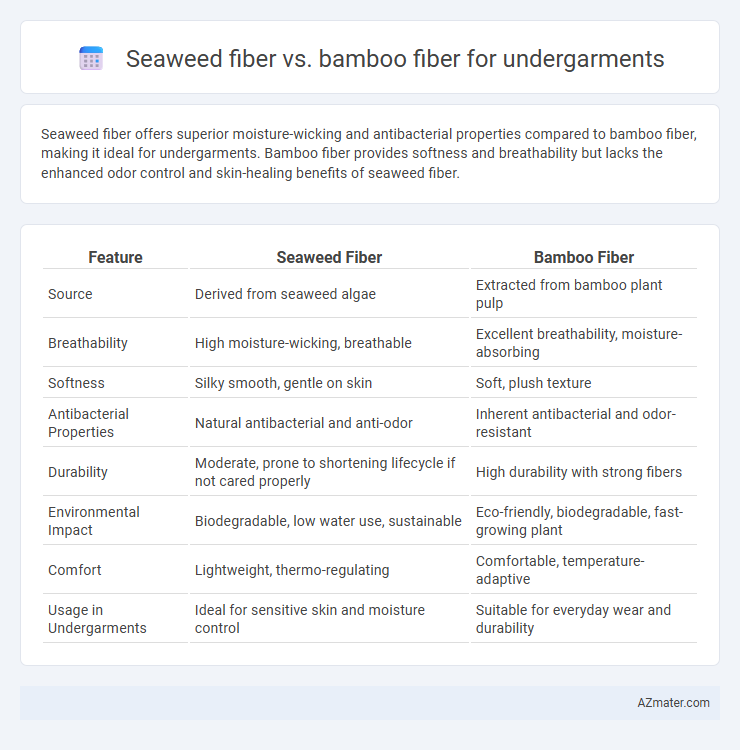Seaweed fiber offers superior moisture-wicking and antibacterial properties compared to bamboo fiber, making it ideal for undergarments. Bamboo fiber provides softness and breathability but lacks the enhanced odor control and skin-healing benefits of seaweed fiber.
Table of Comparison
| Feature | Seaweed Fiber | Bamboo Fiber |
|---|---|---|
| Source | Derived from seaweed algae | Extracted from bamboo plant pulp |
| Breathability | High moisture-wicking, breathable | Excellent breathability, moisture-absorbing |
| Softness | Silky smooth, gentle on skin | Soft, plush texture |
| Antibacterial Properties | Natural antibacterial and anti-odor | Inherent antibacterial and odor-resistant |
| Durability | Moderate, prone to shortening lifecycle if not cared properly | High durability with strong fibers |
| Environmental Impact | Biodegradable, low water use, sustainable | Eco-friendly, biodegradable, fast-growing plant |
| Comfort | Lightweight, thermo-regulating | Comfortable, temperature-adaptive |
| Usage in Undergarments | Ideal for sensitive skin and moisture control | Suitable for everyday wear and durability |
Introduction: Seaweed Fiber vs Bamboo Fiber in Undergarments
Seaweed fiber and bamboo fiber both offer sustainable alternatives for undergarment fabrics, with seaweed fiber derived from marine algae and bamboo fiber sourced from fast-growing bamboo plants. Seaweed fiber is known for its moisturizing properties and natural minerals that promote skin health, while bamboo fiber boasts excellent breathability, antibacterial qualities, and moisture-wicking ability. Comparing these fibers highlights their unique benefits in comfort, eco-friendliness, and functional performance for undergarments.
Material Origins and Sustainability
Seaweed fiber, derived from renewable seaweed biomass, offers natural antibacterial and moisture-wicking properties, making it ideal for sustainable undergarments. Bamboo fiber originates from fast-growing bamboo plants, known for their rapid renewability and biodegradability, contributing to eco-friendly textile production. Both fibers promote reduced environmental impact through renewable sourcing, but seaweed fiber emphasizes ocean-based sustainability while bamboo focuses on terrestrial resource efficiency.
Production Processes Compared
Seaweed fiber production involves dissolving seaweed pulp into a viscous solution that is extruded and solidified into fibers, utilizing environmentally friendly processes with fewer chemicals. Bamboo fiber, often manufactured through mechanical crushing or chemical processing like viscose or lyocell methods, can involve harsher chemicals and higher water consumption. Comparatively, seaweed fiber production tends to have a lower environmental impact and offers natural antibacterial properties, making it a sustainable choice for undergarments.
Texture and Comfort on Skin
Seaweed fiber offers a silky, smooth texture that enhances breathability and moisture absorption, making it highly comfortable for sensitive skin in undergarments. Bamboo fiber is naturally soft, hypoallergenic, and has excellent moisture-wicking properties, providing a cool, comfortable feel throughout the day. Both fibers are eco-friendly, but seaweed fiber excels in a lightweight, second-skin sensation, while bamboo fiber emphasizes durability and softness.
Breathability and Moisture-Wicking Abilities
Seaweed fiber exhibits superior breathability and moisture-wicking properties due to its natural porous structure, allowing efficient air circulation and quick absorption of sweat, making it ideal for undergarments. Bamboo fiber also offers excellent moisture management with its hygroscopic nature, but it tends to retain more heat compared to seaweed fiber, potentially reducing overall breathability. For enhanced comfort in undergarments, seaweed fiber provides a cooler and drier experience, while bamboo fiber is favored for its softness and moderate moisture control.
Antibacterial and Hypoallergenic Properties
Seaweed fiber is renowned for its natural antibacterial properties due to the presence of bioactive compounds such as alginates and polyphenols, which inhibit bacterial growth and reduce odor in undergarments. Bamboo fiber also exhibits strong antibacterial effects, primarily attributed to the presence of bamboo kun, a natural antimicrobial agent, making both fibers suitable for sensitive skin and reducing the risk of irritation. Both seaweed and bamboo fibers are hypoallergenic, but seaweed fiber's additional mineral content enhances skin soothing and moisturizing benefits, giving it a slight edge for individuals prone to allergies or skin sensitivities.
Durability and Longevity
Seaweed fiber in undergarments offers natural antibacterial properties but tends to have lower tensile strength compared to bamboo fiber, impacting durability. Bamboo fiber contains cellulose-based viscose that enhances fabric resilience, making it more resistant to wear and shrinkage over time. For long-lasting undergarments, bamboo fiber provides superior longevity due to its robust structure and moisture-wicking capabilities.
Environmental Impact Assessment
Seaweed fiber for undergarments is highly sustainable due to its rapid renewability and ocean-based cultivation, which requires no freshwater or pesticides, significantly reducing environmental degradation. Bamboo fiber offers natural biodegradability and efficient growth with minimal pesticide use, but its processing can involve chemically intensive methods that may raise environmental concerns. Evaluating the overall environmental impact, seaweed fiber production generally results in lower carbon emissions and reduced water consumption compared to bamboo fiber, making it a more eco-friendly choice for sustainable undergarments.
Price Point and Market Availability
Seaweed fiber generally has a higher price point than bamboo fiber due to its limited production and niche market demand in undergarments. Bamboo fiber is more widely available, benefiting from large-scale cultivation and established supply chains, resulting in more competitive pricing. Market availability for seaweed fiber remains restricted primarily to luxury or eco-conscious brands, whereas bamboo fiber dominates the mass-market segment for sustainable undergarments.
Consumer Preferences and Final Recommendations
Seaweed fiber offers natural antibacterial and moisture-wicking properties preferred by eco-conscious consumers seeking sustainable undergarment options, while bamboo fiber excels in softness and breathability, making it popular for comfort-focused buyers. Consumers increasingly prioritize biodegradability and skin-friendly materials, with seaweed fiber standing out for its unique nutrient-rich composition that promotes skin health. Final recommendations suggest choosing seaweed fiber undergarments for enhanced antimicrobial benefits and environmental impact, whereas bamboo fiber suits those prioritizing luxurious softness and moisture management.

Infographic: Seaweed fiber vs Bamboo fiber for Undergarment
 azmater.com
azmater.com